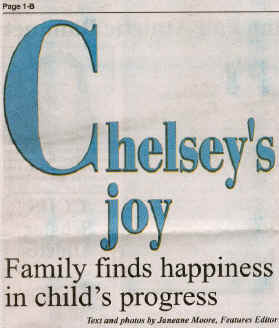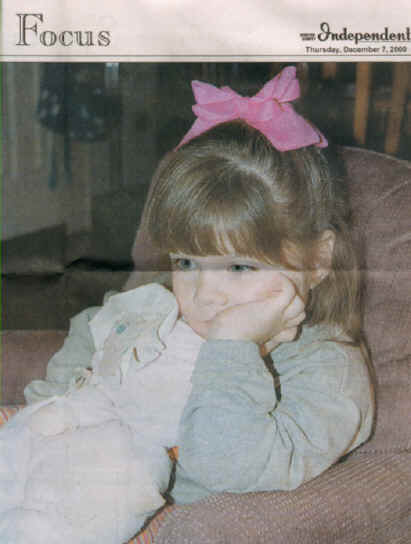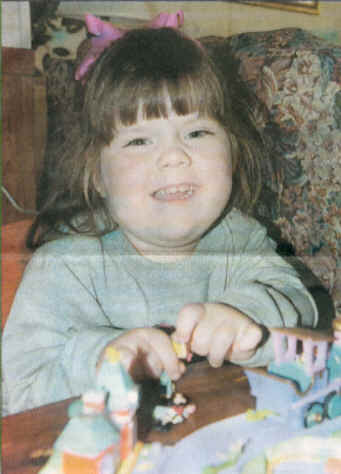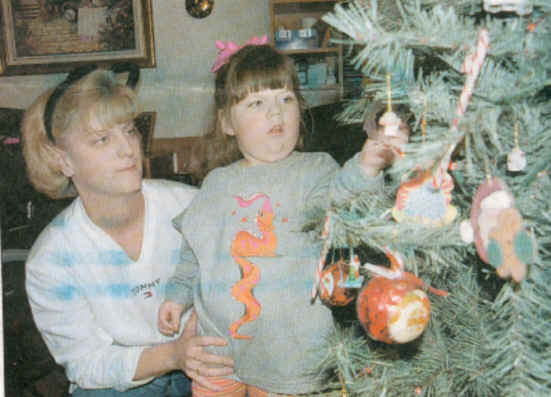 |
 |
 |
 |
 Chelsey is an active, intelligent 3-year-old who is looking forward to a trip to Disney World in the spring. She attends school at East Chester Elementary where a physical therapist assists in her treatment. Wheelchairs for Kids, LeBonheur and Porter Cable recently provided a wheelchair ramp at Chelsey's home. She has a half-sister, Amber, age 16. |
Families
for SMA, a group that sponsors SMA research, is close to finding a cure
for the disease that affects children like Chelsey. For more
information on SMA, write Families of SMA, PO Box 196, Libertyville, IL,
60048 or call 1-800-886-1762. Chelsey can be reached at her
website, www.our-sma-angels.com/Chelsey
|
| Raising
a child with Spinal Muscular Atrophy can be trying at times, but Jeff
and Stephanie Baker find that caring for their daughter, Chelsey, brings
more joy than heartache. Diagnosed with SMA at 22 months, Chelsey
is an intelligent and energetic 3-year-old today. While her motor
functions, particularly her walking skills, are affected by the disease,
Chelsey manages to attend school and remain active in spite of the
crippling illness that hinders her development.
"At 15 months, Chelsey started pulling up and taking a few steps down the couch, but she wasn't walking," said her mother, Stephanie. "At 17 months, she started regressing." Normal milestones like crawling stopped, and Chelsey couldn't raise her entire body off the floor. Noticeable tremors in her hands emerged, and she was referred for evaluation through Tennessee Early Intervention System. A neurologist at LeBonheur Children's Medical Research Center was alerted of Chelsey's symptoms. "He knew what blood tests to do, and within two weeks, he called us back, and we knew," Stephanie said. SMA is a disease of the anterior horn cells, located in the spinal cord. It affects the voluntary muscles that dictate crawling, walking, head and neck control and swallowing. Type I, also called Werdnig-Hoffman Disease, is the most severe form of SMA and the number one genetic killer among children under age 2. Chelsey has Type II, a chronic form of SMA in which its victims suffer a wide range of the disease's progression. Some children may learn to walk with the aid of bracing and may survive into adulthood while others may have severe respiratory problems including fatal pneumonia. Prognosis varies greatly from patient to patient. Both parents must be a carrier of the disease, and there is no known cure for SMA. "The doctors won't say specifically what Chelsey's chances are," Stephanie said, "Many don't live past their late teens or early 20's. I have a hard time believing that now. They know more about the disease now than ever before, and they are close to a cure. "Usually their muscles get weaker and weaker and the child gets sicker and sicker. But Chelsey's strong. A lot of Type II kids have colds all the time and are in and out of the hospital. She is actually stronger now than ever before. She is more active and can do more." Chelsey had physical therapy three times a week and attended the Kiwanis Center in Jackson. Today she is in the Chester County school system at East Chester Elementary School where she can already say her ABCs, count and recite the pledge of allegiance. "She is very intelligent," her mother said. "Her mind won't even be affected in later years." Chelsey has braces on her legs and walks with assistance. She can stand on her own, but can't make her legs cooperate to walk. "We're in the process of getting long braces that the therapist thinks will help her be more mobile," Stephanie said. Currently, Stephanie and Jeff lift their 40-pound daughter and transport her where she wants to go. A stander lets Chelsey be upright to color, draw and write. |
 Three year old Chelsey Baker was diagnosed at 22 months with Spinal Muscular Atrophy, a neurological disease that affects crawling, walking and head and neck movement. SMA affects on in 6,000 live births, and both parents must be carriers of the gene that causes it. Chelsey is shown standing, with the help of her mother, Stephanie, at the family's Christmas tree. |
"She's
a good kid...pretty easy going," Stephanie said. "There
are times when she wants to go from toy to toy, and I guess she gets
frustrated. But she's pretty content most of the time."
Chelsey doesn't seem to notice her differences as much as she does her similarities to other children. "She doesn't really ask any questions about the disease, and I haven't really told her much," Stephanie said. "She makes comments like 'I can stand up like Hailey,' so I know she realizes when she is like someone, but she never says anything about being different." Currently, Chelsey is excited about Christmas and an upcoming trip to Disney World. She has asked Santa for a Barbie airplane and a Baby Born. After attending an SMA conference in St. Louis, MO., the Bakers were encouraged with Chelsey's prognosis. "There were people with SMA in their 40s and 50s," Stephanie said. "It makes us feel better about Chelsey's future." Ongoing research through the Indiana University Roster, which is funded by Families of SMA, continues to be a useful tool in a quest to correct the gene disorder. |
| Researchers
throughout the country are funded by Families of SMA, a group that seeks
to uncover a cure for SMA. Looking at all possibilities from
nutrition to missing proteins to neurotrophic-based drugs, Families of
SMA believes that they are on a cusp of a cure of this debilitating and
deadly disease.
Last weekend in New York City, Families of SMA sponsored an awareness-raising event at the JVC billboard. The organization's founder and a father of a 9-year-old SMA child sat atop the billboard for 36 hours-10 seconds for every life taken by SMA each year. "We want the public to know what SMA is," Stephanie said. "I want everyone to know about Chelsey because I may do a fund-raiser for Families of SMA in the spring. We are so close to a cure." As Chelsey grows in age, imagination and maturity, she is sure to have questions about her condition. The Bakers are content to take each day as it comes, answering questions and dealing with problems as they arise. "I can't imagine how life would be without her," Stephanie said. "I'm thankful she's as healthy as she is. I know how much worse it could be." "We try not to think about (her life expectancy). I have come to tell myself that nobody is guaranteed tomorrow. I am just thankful for the time I have with her. She is a special, precious child, and she makes my life better. She is a joy to raise." |